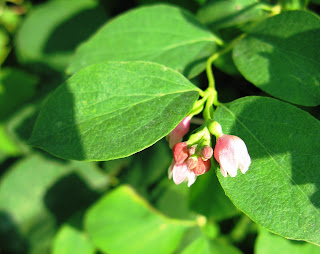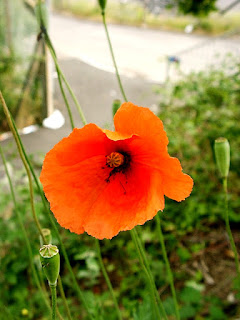This blog may help people explore some of the 'hidden' issues involved in certain media treatments of environmental and scientific issues. Using personal digital images, it's also intended to emphasise seasonal (and other) changes in natural history of the Swansea (South Wales) area. The material should help participants in field-based modules and people generally interested in the natural world. The views are wholly those of the author.
Wednesday, 31 May 2017
Tuesday, 30 May 2017
Monday, 29 May 2017
Sunday, 28 May 2017
Saturday, 27 May 2017
Tuesday, 23 May 2017
Sunday, 21 May 2017
Saturday, 20 May 2017
Gone to Seed Bank?
It was mean't to provide long-term insurance against man-made disasters resulting in the loss of important crop plants, when it was opened, in 2008, deep in the permafrost of Svalberg on the island of Spitzbergen in Norway, but the Global Seed Vault has already been threatened by yer humans (https://www.theguardian.com/environment/2017/may/19/arctic-stronghold-of-worlds-seeds-flooded-after-permafrost-melts). Rising temperatures have already flooded the entrance to the bank which contains almost a million packets of seeds from around the world. Fortunately, none of the seeds have been lost thus far but it is an illustration that we are pretty good at our man-made disasters.
Friday, 19 May 2017
Wednesday, 17 May 2017
Tuesday, 16 May 2017
To No Porpoise
The world's smallest porpoise, the Vaquita marina (Phocoena sinus) of Mexico, in spite of protections by the US navy and other organisations is reportedly on the verge of extinction (https://www.theguardian.com/environment/2017/may/16/chinese-appetite-totoaba-fish-bladder-threatens-rare-vaquita). This is, apparently, due to an insatiable appetite in Chinese medicine (aren't so many things?) for the swim bladder of the, also endangered, Totoaba macdonaldi fish that swims in the same seas. The swim bladders, regarded as a cure-all, can retail for around $20,000 per kilogram (and can be simply posted to China). Fishermen in Mexico apparently use illegal gillnets to catch the fish. Unfortunately, these devices frequently drown the porpoises who cannot return to the surface in order to breathe
Plastic Shores!
The suggestion that we are essentially in a 'new' Geological era, dominated by humans and their waste has been given enormous support by a study looking at washed up plastics on Henderson island in the Pitcairns of the South Pacific (https://www.theguardian.com/environment/2017/may/15/38-million-pieces-of-plastic-waste-found-on-uninhabited-south-pacific-island). It has been estimated that this tiny, uninhabited atoll has circa 38 million pieces of plastic on its shores and buried in its sands (remarkably, making it one of the most polluted places on the planet). This means that almost 18 tonnes of this human-generated waste has arrived by wave action, endangering habitats and species. As it takes hundreds of years for the plastics to biodegrade, only waste removal exercises will reduce it (and this is pointless if more material simply washes up to replace it). Those humans are messy animals!
Monday, 15 May 2017
Saturday, 13 May 2017
Hacked to Death?
The widespread Ransomwear attack to computer records, including some of UK hospital trusts and GP services (https://www.theguardian.com/technology/2017/may/13/cyber-attack-on-nhs-sparks-bitter-election-battle) using soft-wear apparently stolen from the USA government spy teams might, at a distance, seem like a fairly victimless crime. Besides, however, delaying some hospital procedures, such tactics could seriously compromise the health of people whose information is held in the encrypted records. It would not be impossible that a few individuals might die (all for a few hundred Bitcoins). Murder by hack?
Thursday, 11 May 2017
Wednesday, 10 May 2017
Jelly-wobbler!
A study carried out at Galway University has revealed that vinegar is the best treatment for the sting of the Portughese Man O'War (https://www.theguardian.com/environment/2017/may/09/vinegar-best-antidote-jellyfish-stings-urine-lemon-juice-make-worse-study). Traditional urinating on the sting or applying lemon juice simply exacerbated the condition. It may be the case, that stings from different jellyfish species respond differently but it would be easy to take a small vial of vinegar to the beach. I used to be told that steak tenderiser was best for some stings but might take this with a pinch of salt.
Dairy Isn't So Scary?
A meta-analysis (where a collection of related studies are combined to greatly increase the statistical power) of investigations looking at the effects of dairy products on human health has seemingly torpedoed the simple claim that consumption can be linked to heart attacks and strokes (https://www.theguardian.com/society/2017/may/08/consuming-dairy-does-not-raise-risk-of-heart-attack-or-stroke-study). This might be somewhat embarrassing to nutritionists and other health professionals who generally recommend people to switch, where possible, to 'low fat' alternatives for milk, yoghourt and cheese. It might not protect them from heart attacks but doing so would at least tend to reduce calorie intake (fats are high calorie) and counter tendencies to become obese. There is a substantial industry generating ranges of low fat food products. Personally, I like a bit of regular cheese along with my butter!
Monday, 8 May 2017
Cow Catcher?
Seems to be a question of priorities? News that an Indian state is to develop a fleet of ambulances to deal with injured cows (https://www.theguardian.com/world/2017/may/08/cow-ambulances-indias-latest-scheme-to-protect-revered-animal) in a country where ill people often have to have their families transport them to hospital sounds, at first read, a bit odd to Western sensibilities. The cow, however, is a sacred animal to Hindus (people, especially of other religions, have reportedly been lynched for killing these animals in parts of India). Having said that, Europe does have ambulances and hospitals for injured companion and some wild animals. It would be nice if humans could also be priorities in India.
Saturday, 6 May 2017
Subscribe to:
Comments (Atom)
-
I n the UK and US, a pparently popular and successful vegan/vegetarian restaurants are reportedly closing or adding meat to their menus ( ...
-
Early ripening fruit may seem convenient but some folk think it confirms environmental stress. There's also a possibility th...






















































%20mating%20NWCW.jpg)

